Let’s talk about cake. A slice of cake is so commonplace in British cafes that it’s almost compulsory with your cup of tea or fancy coffee.
Cake, a bit like sex or cheese toasties, is one of those things that is good even when it’s pretty bad. Yet, we’re so used to the same formula in cakes that it can be quite shocking to see something that doesn’t fit those tired criteria.
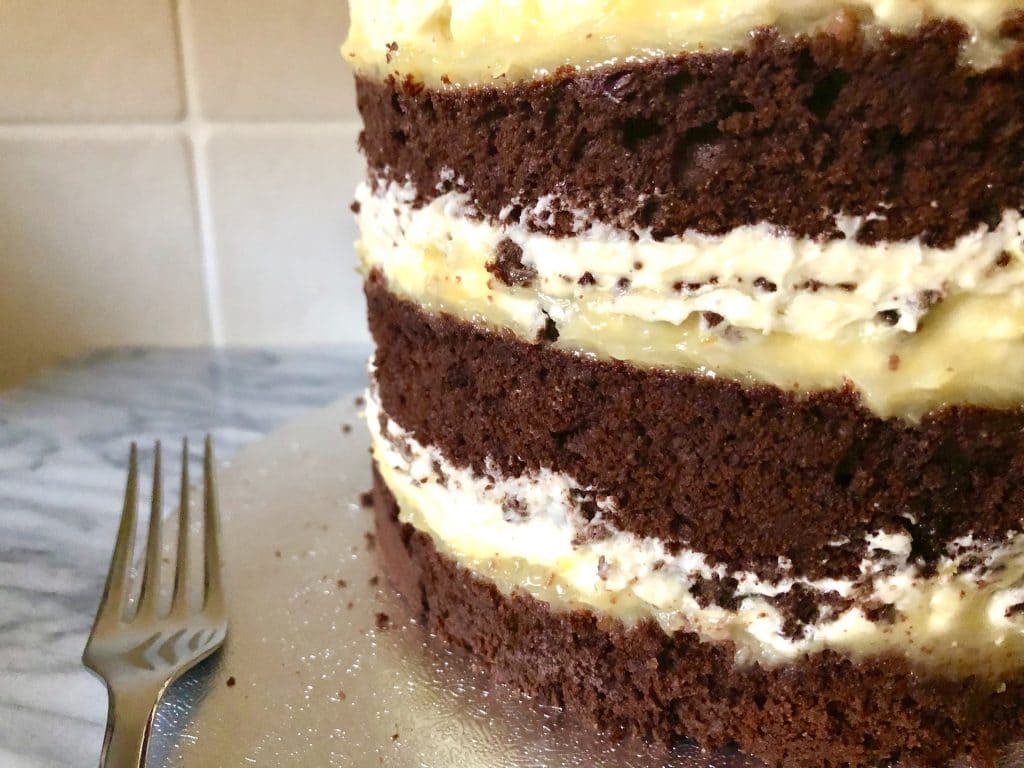
I’m talking about the sandwich cake, with one stingy layer of frosting in-between and a thick layer around the top and edges. It’s fine, but it leaves out SO much opportunity for flavour and texture in a cake. Usually it also results in there being nowhere near enough frosting, despite a layer of it covering up all the lovely colour and crumb to be found inside. An inexcusable offence.
Christina Tosi was the first person to really open my eyes to this. She is the genius behind the Momofuku Milk Bar in NYC, who I have prattled on about many times before. She really highlighted that hiding the gorgeous layers of a cake behind some bland-looking frosting was a real shame, and that a cake can have more than just two textures of course!
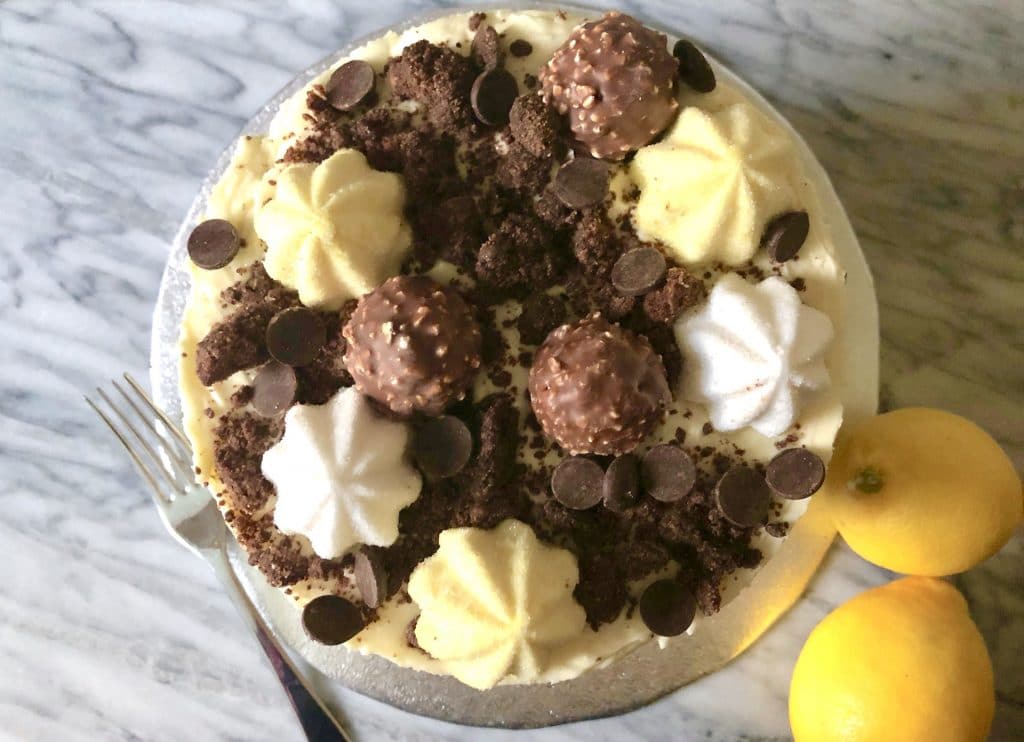
Based on that, this Dark Chocolate Lemon Layer Cake was a chill little experiment in my kitchen on a Saturday afternoon while I pushed my uni work to one side. I wanted bitter, I wanted sweet, I wanted crunchy, I wanted creamy. All in one mouthful. That’s what I set out for.
Moist, dense, crumbling dark chocolate cake layers. Sharp homemade lemon curd. Fluffy and sweet vanilla marshmallow frosting. Crisp nuggets of chocolate cookie crumb.
This Dark Chocolate Lemon Layer Cake provides crunchiness, smoothness, sweetness and gentle bitterness. Chocolate and lemon aren’t a common pairing, especially when compared to the prevalence of chocolate and orange, but there is no good reason why they shouldn’t be.

I won’t lie, it’s not the easiest cake to bake and construct, but if you have a lazy afternoon ahead and you want something truly mind-blowing in your mouth (hehehe) then it’s worth every minute.
The construction of this Dark Chocolate Lemon Layer Cake is very similar to the Momofuku Milk Bar Birthday Cake. I find their style of cake-assembly so fascinating that I’ve been doing it so I had to try it again. If you want to mimic it, you’ll need a cake ring and some acetate. These aren’t exactly store-cupboard staples, so you can easily use a couple of 9″ classic sandwich cake tins, with the other components squidged in the centre of the baked and assembled cake, and it will still taste every bit as good!
Dark Chocolate Lemon Layer Cake
Notes
BE A MAVERICK: No cake ring or acetate? Simply bake the cake in a couple of 9″ sandwich cake tins and assemble like a normal sandwich cake instead!
*MAKE IT GLUTEN FREE: simply swap out the plain flour for a gluten free plain flour blend*
Ingredients
For the lemon curd (feel free to use shop-bought instead):
- 100g caster sugar
- 50g unsalted butter
- 2 lemons
- 2 large eggs
For the chocolate cake:
- 200g soft unsalted butter or margarine
- 200g soft brown sugar
- 1 tsp vanilla extract
- 2 large eggs
- 1 egg yolk
- 150g self-raising flour
- 50g cocoa powder
- 100g dark chocolate, melted
- Pinch of salt
For the chocolate cookie crumb:
- 100g caster sugar
- 100g self-raising flour
- 100g dark chocolate, melted
- 2 tbsp vegetable oil (I used a light olive oil)
- Pinch of salt
For the marshmallow frosting:
- 200g soft unsalted butter
- 150g icing sugar
- 100g vanilla Marshmallow Fluff
- 1 tsp vanilla extract
- Splash of milk to soften (if necessary)
Instructions
For the lemon curd (feel free to use shop-bought instead):
- Set a heatproof bowl set over a pan of simmering water.
- Pop the sugar, butter, lemon juice and lemon zest into the bowl and stir until melted together.
- In a separate bowl, beat your eggs with a fork until the yolk and white are mixed together.
- Whisk the beaten eggs slowly into your warm, melted mixture.
- Continue whisking gently until the mixture has thickened into a pouring-custard consistency. (It will thicken up into proper curd as it cools!)
- Remove the bowl from the heat and allow the curd to cool to room temperature before chilling in the fridge while you make the rest of your cake!
For the chocolate cake:
- Preheat your oven – 180 C / 160 C fan / 350 F / gas mark 4.
- Grease and line a 25cm x 31cm (10in x 12in) rectangular baking tray or roasting tin.
- In a large bowl, beat together your butter, sugar and vanilla until noticeably paler and fluffier.
- Plop the eggs in one at a time, beating well between each addition. (Don’t worry if the mixture looks a little bit funny at this point, it will sort itself out when you add the flour!)
- Gently stir the flour, cocoa, melted chocolate and salt into the bowl until you have a smooth brown cake mixture.
- Pour the mixture into your prepared tin, smooth out the top, and bake in the preheated oven for 25-35 minutes. When baked it should be risen, dark brown, and a skewer inserted into the centre should come out clean.
- Allow to cool completely in the tin.
- Keep your oven on to bake the chocolate crumb!
For the chocolate cookie crumb:
- In a large bowl, stir together all the ingredients for the chocolate cookie crumb until you have a dark, clumpy but sandy consistency.
- Spread the crumbs across a greaseproof-paper lined baking tray.
- Bake for 20 minutes until slightly darker in appearance. They may still feel moist but will firm and crisp up as they cool.
- Set aside to cool completely.
For the marshmallow frosting:
- Beat all frosting ingredients together in a large bowl until you have a pale, fluffy frosting. Feel free to add a little more icing sugar or Fluff to achieve a thicker or softer frosting!
To assemble:
- Use your cake ring (adjusted to 15cm if it is adjustable) to cut out two circles of cake. Gather up the scraps as this will form the bottom layer of your cake.
- Clean and dry the cake ring and place it either on a board, baking tray or the plate you want to serve it on.
- Line the sides of the cake ring with a strip of 7.5cm x 50cm acetate.
- Put the cake scraps inside the ring and use your hand to press them down into a flat even layer.
- Spread over a couple of tablespoons of the lemon curd.
- Spread one-fifth of your frosting on top.
- Scatter over one-third of the cake crumbs, pressing them down gently into the frosting.
- Spread another fifth of the frosting carefully over the crumbs.
- Place a second piece of acetate between the first piece and the cake ring, to help support the higher layers.
- Repeat the entire assembly process again for the second and third layer. You should have used up all of your cake and frosting. You will have curd and crumbs left (for snacking purposes!).
- Pile as many chocolate/lemon decorations as you like onto the top of the cake as you like.
- Place the cake in the fridge to chill for 1-2 hours until the frosting is firm.
- Gently remove the cake ring and peel off the acetate.
- Slice up and enjoy!
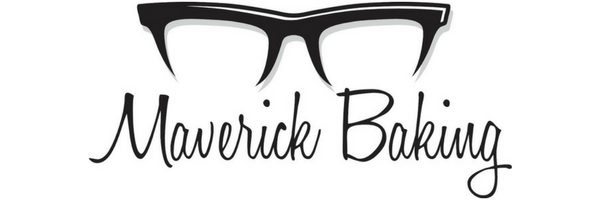
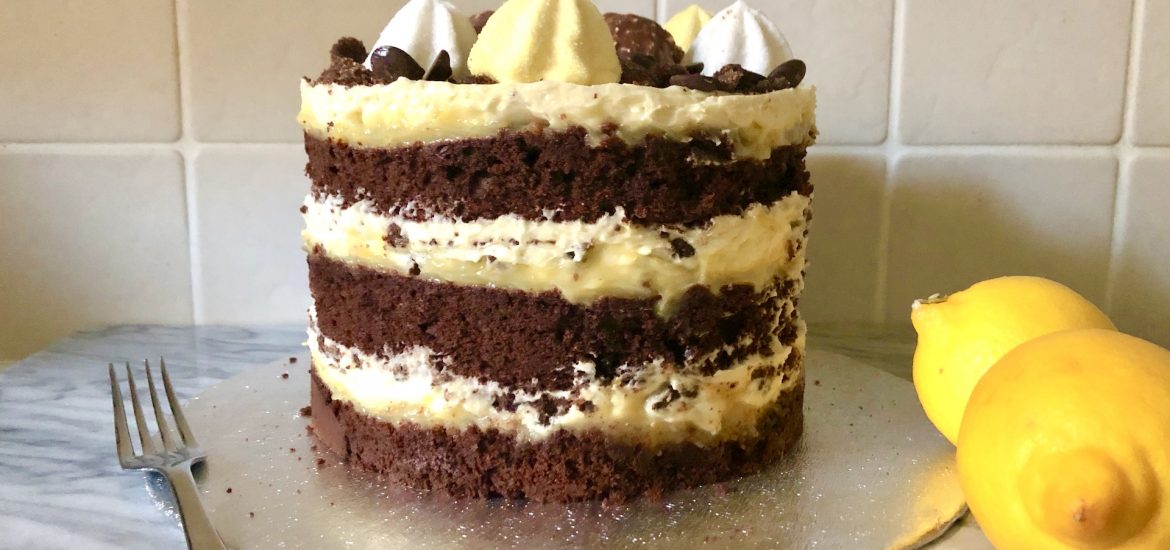

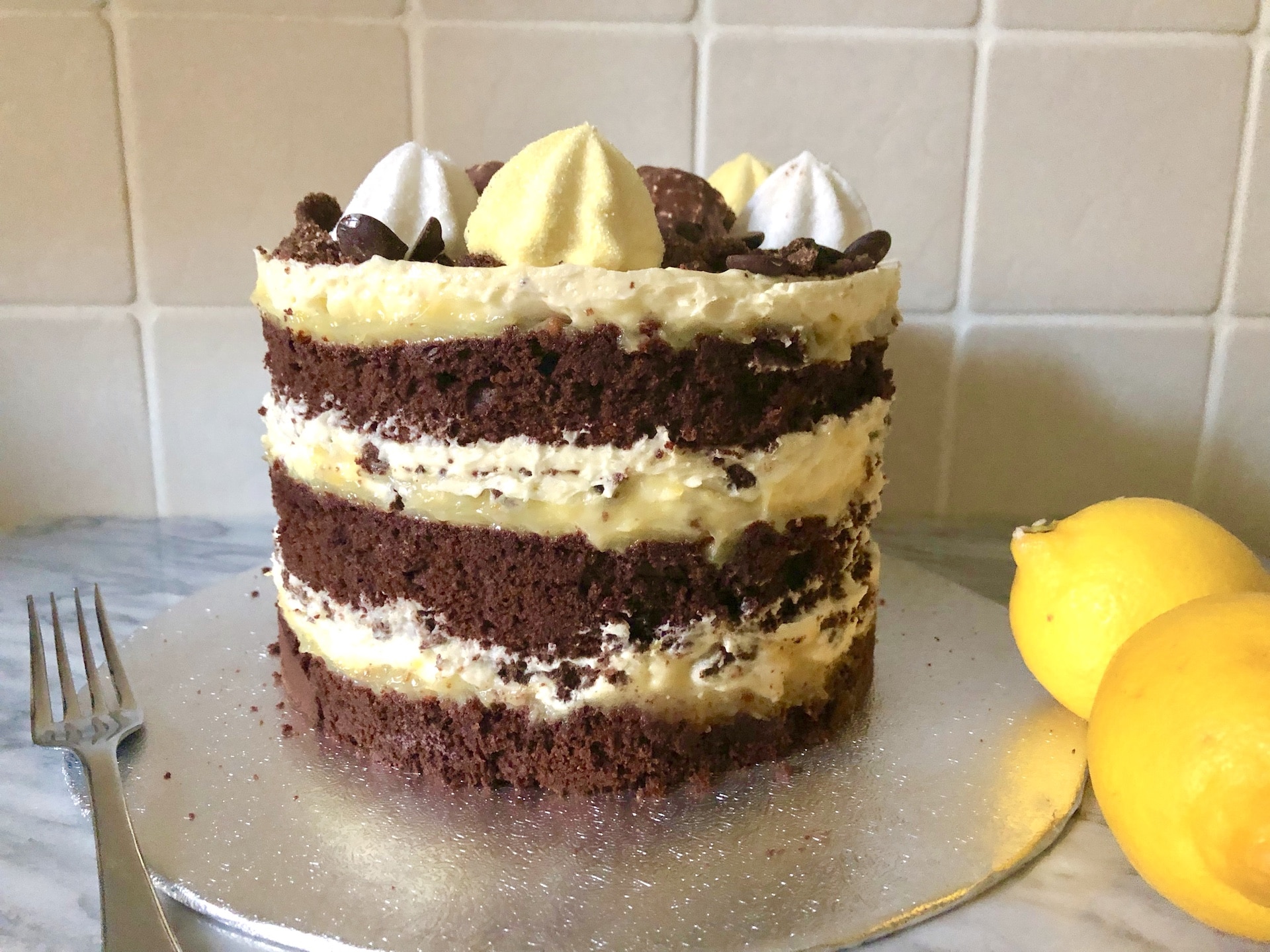
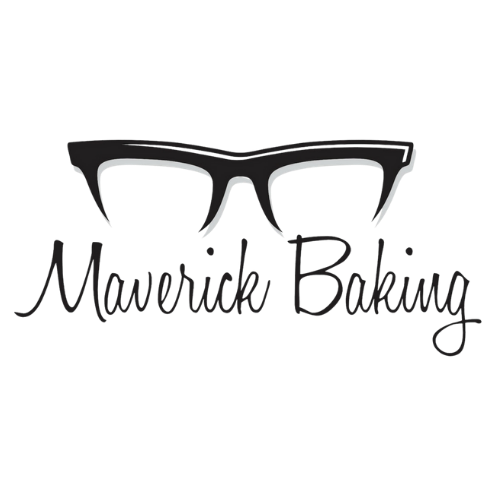
[…] GET FULL RECIPE HERE […]
I also made this, and the cake was hard and crumbly. I cooked for less time based on the original post. I would make again but with a different cake or with a lemon syrup to moisten. the cake.
LeeJ
I tried this and something went very wrong with the cake. The lemon curd and everything else went well, but the cake was terrible. Dry, crumbly and very bitter and didn’t rise at all. There didn’t seem to be nearly enough moisture in the batter. Is all the liquid really supposed to come from just two eggs and one yoke? No milk? No oil?
My batter had more of a paste consistency. I definitely would not use the recipe as is.
You know, I take it back about the lemon curd also, which never set. I thought it was weird to use egg white in the curd, I’ve always just seen using yolks. And mixing the egg in at then end with just the warm mixture clearly wasn’t enough to cook the egg, so as the curd tried to set the egg was still raw, keeping it from setting, and also making it not safe to eat.
Hi Jerod, I’m very sorry to hear this recipe didn’t turn out correctly for you.
– Regarding the cake. A dry crumbliness may likely be due to over-baking? Every oven is very different, I find I have to make small timing tweaks in my family home’s oven compared to the one in my own apartment for example! It is not typical in British cake recipes to use milk or oil, and the combination of butter, eggs, and melted chocolate should add plenty of moisture to the cake batter. As for there being no rise, if you did use self-raising flour, it being a bit past its best is the only explanation I can think of? Even the well-beaten butter and sugar should provide even a small rise?
– Regarding the curd: The curd should continue to be stirred in the bowl over the heat once the eggs are added. As the recipe states, the mixture should thicken before removing the bowl from the heat, allow the eggs to safely cook and allowing the setting process to begin before cooling/chilling.
I hope that helps somewhat!
Any recipe that tells me to “plop” the eggs in is my kind of recipe! I was voluntold to make this cake for my nephew’s birthday and I shall comply. Honestly, though, if I had stumbled across it on my own, I would have drooled over the photo until I gave in and made it just to know how delightfully chocolatey-lemon-marshmallowy it is! 🤤
How I came upon your recipe is simple. I dreamed about it last night that I ate chocolate cake with a lemon curd and now I am reading your recipe…I didn’t even know if it was a combination that existed out there. I will however copy and paste this recipe and try it.
Hi,
I am going to try this for my Dad’s birthday as it was his requested combination! I wish you had a print button for the recipe and a conversion for us yanks! LOL
Hi Christine, hope you enjoy! If you view the recipe on a desktop/laptop there is a wee print icon just until the title of the recipe card! All of my newer recipes do come with a US conversion, but I’d recommend this site otherwise: https://www.thecalculatorsite.com/cooking/cups-grams.php
Marshmellow frosting ewwwwww what is that tho